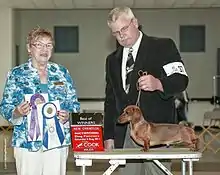Miniature Dachshund
Miniature dachshunds are a smaller version of the standard dachshund. Some of their nicknames include "wiener dogs", "hot dogs", or "sausage dogs."

History
The dachshund was developed in Germany and has existed since at least the 16th century. The name dachshund comes from the German words dachs (badger) and hund (dog). Dachshunds first came to the United States in 1870, imported to hunt rabbits, and gained official recognition in 1885. During the late 19th century, German hunters desired smaller dachshunds to be used on European hares, which lived in smaller burrows than the dachshunds' historic quarry the badgers and foxes. At first, some of the miniature dachshunds were just runts of their litters, but later others were created intentionally by crossing dachshunds with toy terriers and pinschers. Most of the miniature dachshunds produced this way did not have the characteristics of the dachshund (particularly its hunting prowess), however, and this type of crossbreeding was abandoned by 1910 in favor of the more time-consuming process of reducing the size of the dachshund through many generations of selective breeding.
Appearance and characteristics
Like their standard-sized counterparts, miniature dachshunds come in three coats: smooth, long-haired, and wire-haired. They also come in a variety of colors and patterns: red, cream, black and tan, blue and tan, chocolate and tan, and Isabella and tan. The coat patterns seen in dachshunds are brindle, dapple (or merle), piebald and sable. Miniature dachshunds have a typical weight of 8 to 11 pounds in the United States.[1] They also are normally a height of 5 to 7 inches at the withers.


Miniature dachshunds are low to the ground, long in body and short of leg, with robust muscular development. Where the muscles contract, the skin of the miniature dachshund is elastic and pliable without excessive wrinkling. Appearing neither crippled, awkward, nor cramped in their capacity for movement, the miniature dachshund is well-balanced with bold and confident head carriage and intelligent, alert facial expression. The keen nose gives them an advantage over most other breeds for trailing.
There is only one size of miniature dachshund in the United States, Great Britain, and most English-speaking countries. In Germany and those countries which belong to the Fédération Cynologique Internationale (World Canine Federation), however, there are actually two smaller-sized dachshunds: miniature (zwerg) and rabbit (kaninchen). The kaninchen are smaller than the FCI miniature dachshunds, and the two sizes are differentiated by chest circumference rather than weight.
Temperament
Bred to hunt, miniature dachshunds are high-spirited and independent by nature. They have a keen intelligence and the ability to think on their own has been highly cultivated. All varieties have their own brand of charm since they have slightly differing ancestry that helped in the development of the coats. They are great for families that have older children, as they need patience and maturity to be handled well. They are also devoted to their families and will bark loudly when strangers are near, yet generally accept that same stranger after an introductory period.[1][2]
Health and care
Miniature dachshunds can live comfortably in both rural and urban areas. They are very active dogs and benefit from daily exercise. The long-haired and wire-haired varieties need weekly brushing. Miniature dachshunds usually live at least 12 to 14 years (and often longer). Due to their long spines, dachshunds in general are prone to back problems, and actions such as jumping from a couch may be dangerous. Purchasing dog-friendly stairs or ramps is a recommended way of alleviating this issue. A disease that is common in both the miniature dachshund and its standard counterpart is Intervertebral Disc Disease (IVDD).[3] Onset of this disease typically occurs between 3 and 6 years of age. Complications that may occur are paralysis in the hind legs and the loss of control of the urinary bladder and bowel movements. Other potential health problems include hip dysplasia, eye issues such as Progressive Retinal Atrophy (PRA) and obesity. [4] A DNA test for PRA is available for miniature long-haired dachshunds.
References
- "NMDC Standard of the Dachshund". National Miniature Dachshund Club.
- American Kennel Club. (2012). Get to know the Dachshund. Retrieved December 10, 2012, from American Kennel Club website: http://www.akc.org/breeds/dachshund/index.cfm
- Discovery. (2012). Dachshund (Miniature) guide. Retrieved December 7, 2012, from Animal Planet website: http://animal.discovery.com/breed-selector/dog-breeds/hound/dachshund-miniature.html
- Dig-In. (2017). 5 Common Dachshund Health Problems. Retrieved September 30, 2018, from Dig-In website: https://www.dig-in.com.au/5-common-dachshund-health-problems/
